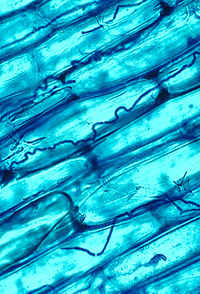Epichloë coenophiala
| Epichloë coenophiala | |
|---|---|

| |
| Scientific classification | |
| Domain: | Eukaryota |
| Kingdom: | Fungi |
| Division: | Ascomycota |
| Class: | Sordariomycetes |
| Order: | Hypocreales |
| Family: | Clavicipitaceae |
| Genus: | Epichloë |
| Species: | E. coenophiala
|
| Binomial name | |
| Epichloë coenophiala (Morgan-Jones & W.Gams) C.W. Bacon & Schardl
| |
| Synonyms | |
| |
Epichloë coenophiala is a systemic and seed-transmissible endophyte of tall fescue, a grass endemic to Eurasia and North Africa, but widely naturalized in North America, Australia and New Zealand. The endophyte has been identified as the cause of the "fescue toxicosis" syndrome sometimes suffered by livestock that graze the infected grass. Possible symptoms include poor weight gain, elevated body temperature, reduced conception rates, agalactia, rough hair coat, fat necrosis, loss of switch and ear tips, and lameness or dry gangrene of the feet. Because of the resemblance to symptoms of ergotism in humans, the most likely agents responsible for fescue toxicosis are thought to be the ergot alkaloids, principally ergovaline produced by E. coenophiala.[1]
Continued popularity of tall fescue with this endophyte, despite episodic livestock toxicosis, is attributable to the exceptional productivity and stress tolerance of the grass in pastures and hay fields. The endophyte produces two classes of alkaloids, loline alkaloids and the pyrrolopyrazine, peramine, which are insecticidal and insect deterrent, respectively, and presence of the fungus increases drought tolerance, nitrogen utilization, phosphate acquisition, and resistance to nematodes.[2][3] Recently, natural strains of E. coenophiala with little or no ergot alkaloid production have been introduced into tall fescue for new cultivar development. These strains are apparently not toxic to livestock,[4] and also provide some, but not necessarily all, of the benefits attributable to the "common toxic" strains in the older tall fescue cultivars.[3][4]
Epichloë coniophiala was originally described as an Acremonium species and later moved to the anamorphic form genus Neotyphodium. Today, it is classified in Epichloë.[5] Molecular phylogenetic analysis indicates that E. coenophiala is an interspecific hybrid with three ancestors: E. festucae, a strain from the Epichloë typhina complex (from Poa nemoralis) and a third, undescribed or extinct species similar to the Lolium associated clade of Epichloë baconii that also contributed a genome to the hybrid endophyte E. occultans, among others.[6][7]
References[edit]
- ^ Lyons PC, Plattner RD, Bacon CW (1986). "Occurrence of peptide and clavine ergot alkaloids in tall fescue grass". Science. 232 (4749): 487–489. doi:10.1126/science.3008328. PMID 3008328.
- ^ Malinowski DP, Belesky DP (2000). "Adaptations of endophyte-infected cool-season grasses to environmental stresses: Mechanisms of drought and mineral stress tolerance". Crop Sci. 40 (4): 923–940. doi:10.2135/cropsci2000.404923x.
- ^ a b Timper P, Gates RN, Bouton JH (2005). "Response of Pratylenchus spp. in tall fescue infected with different strains of the fungal endophyte Neotyphodium coenophialum". Nematology. 7: 105–110. doi:10.1163/1568541054192216.
- ^ a b Parish JA, McCann MA, Watson RH, Paiva NN, Hoveland CS, Parks AH, Upchurch BL, Hill NS, Bouton JH (2003). "Use of nonergot alkaloid-producing endophytes for alleviating tall fescue toxicosis in stocker cattle". Journal of Animal Science. 81 (11): 2856–2868. doi:10.2527/2003.81112856x. PMID 14601890.
- ^ Leuchtmann, A.; Bacon, C. W.; Schardl, C. L.; White, J. F.; Tadych, M. (2014). "Nomenclatural realignment of Neotyphodium species with genus Epichloë" (PDF). Mycologia. 106 (2): 202–215. doi:10.3852/13-251. ISSN 0027-5514. PMID 24459125. S2CID 25222557. Archived from the original (PDF) on 2016-03-07. Retrieved 2016-02-28.
- ^ Tsai HF, Liu JS, Staben C, Christensen MJ, Latch GC, Siegel MR, Schardl CL (1994). "Evolutionary diversification of fungal endophytes of tall fescue grass by hybridization with Epichloë species". PNAS. 91 (7): 2542–2546. doi:10.1073/pnas.91.7.2542. PMC 43405. PMID 8172623.
- ^ Moon CD, Craven KD, Leuchtmann A, Clement SL, Schardl CL (2004). "Prevalence of interspecific hybrids amongst asexual fungal endophytes of grasses". Molecular Ecology. 13 (6): 1455–1467. doi:10.1111/j.1365-294X.2004.02138.x. PMID 15140090. S2CID 11295842.
